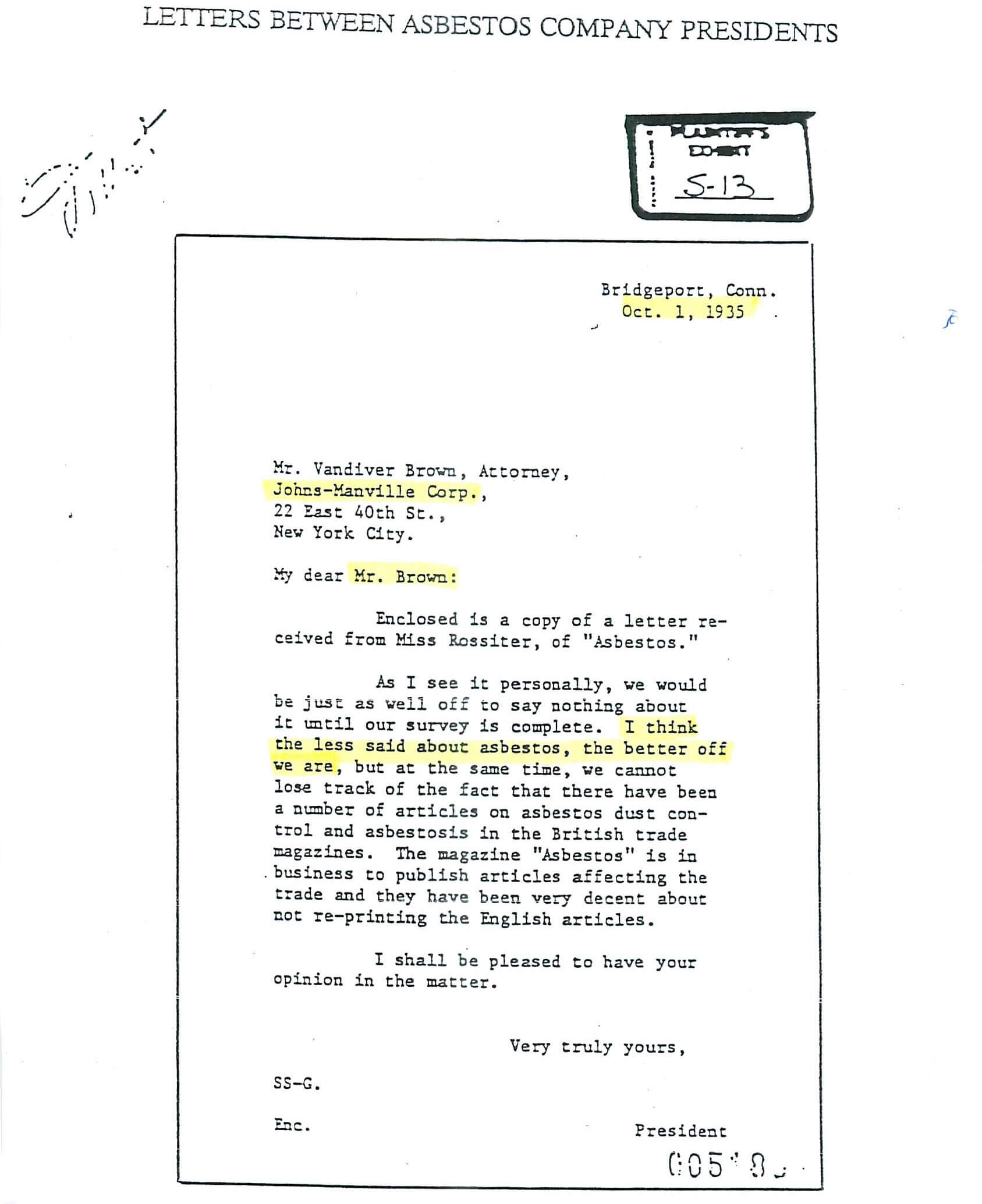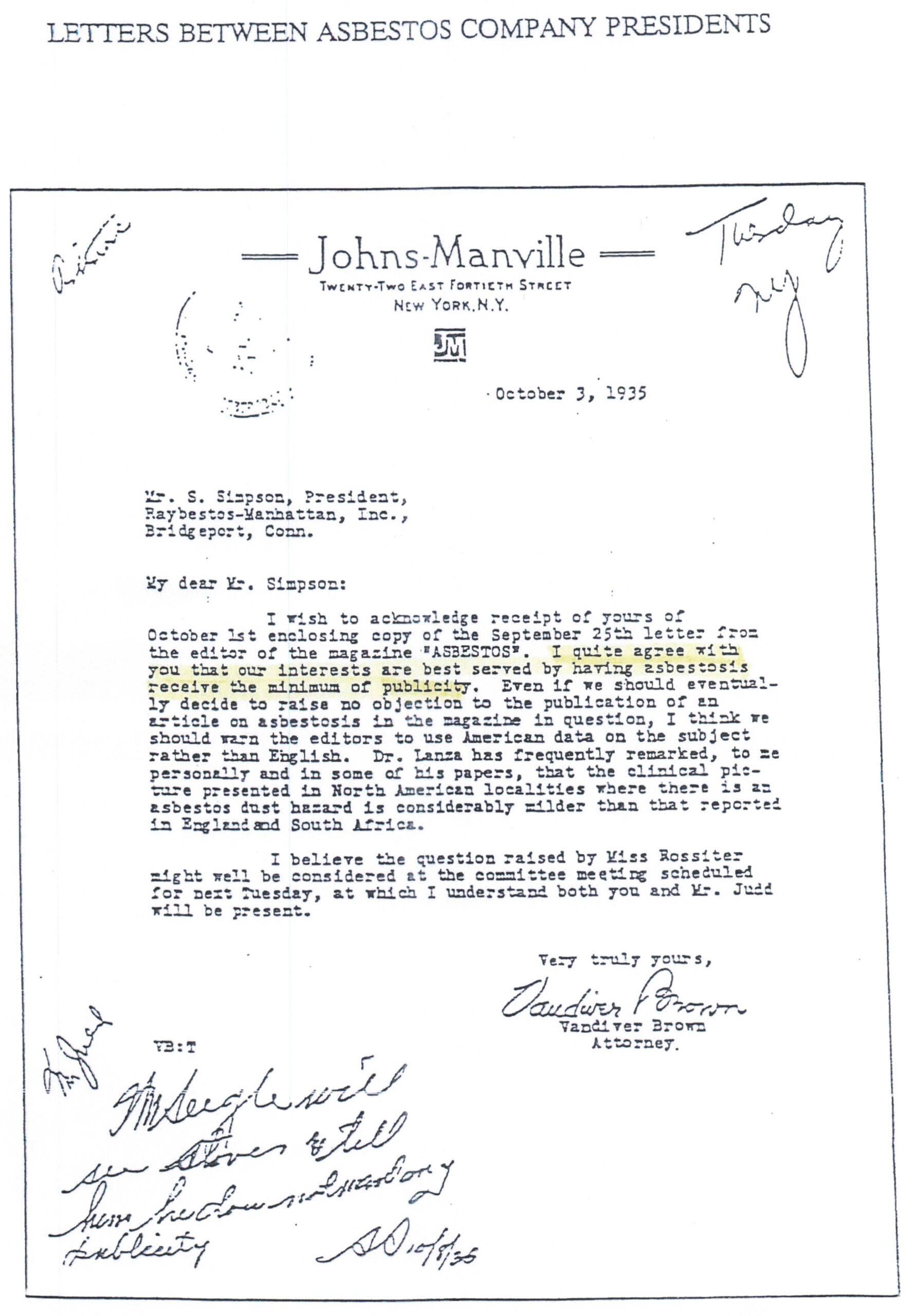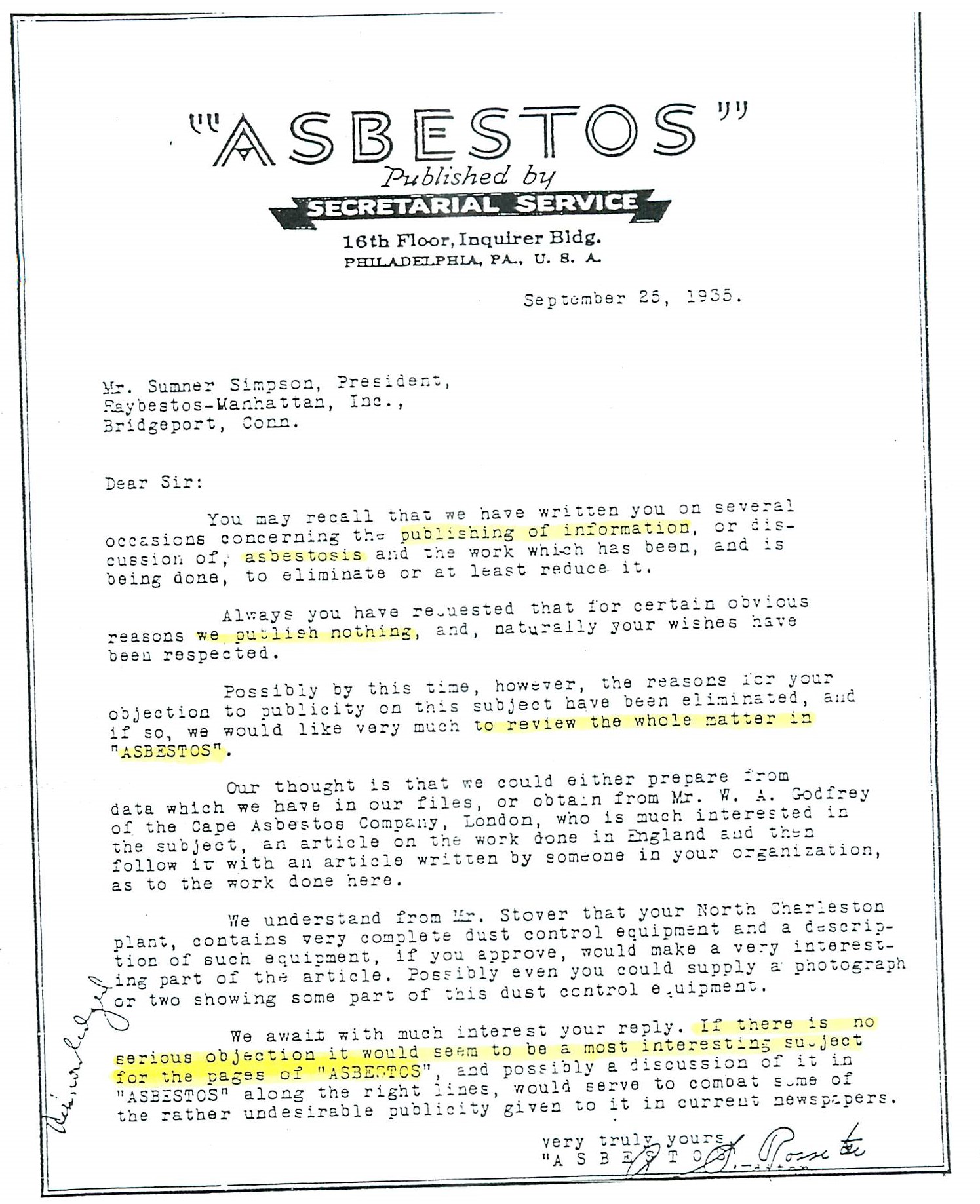Manufacturer Asbestos Cover-Up
The dangers of asbestos have been well-documented for decades, yet numerous companies within the asbestos industry chose profit over people’s health, engaging in a massive manufacturer asbestos cover-up to hide the lethal effects of asbestos products. This blog post delves into the historical cover-ups by various asbestos manufacturers, the subsequent litigation, and the ongoing impact on public health. We will examine key players like Johns-Manville Corporation, Johnson & Johnson, Babcock & Wilcox, and others, detailing how their actions have led to numerous asbestos-related diseases and the establishment of asbestos trust funds to compensate victims.
The Dangers of Asbestos
Asbestos is a naturally occurring mineral that was widely used in various industries due to its resistance to heat, fire, and chemicals. It was commonly found in construction materials, automotive parts, and household products. Despite its beneficial properties, the health hazards associated with asbestos exposure are severe. Asbestos fibers, when inhaled, can cause life-threatening diseases, including asbestosis, lung cancer, and mesothelioma, a rare form of cancer that affects the lining of the lungs, heart, or abdomen.
Health Risks and Asbestos-Related Diseases
Exposure to asbestos is dangerous because the fibers can become lodged in the respiratory system, leading to inflammation, scarring, and eventually cancer. Asbestos-related diseases often have a long latency period, meaning symptoms may not appear until decades after exposure. This delay makes it challenging to diagnose and treat conditions early, often resulting in poor prognoses for affected individuals.
Historical Context: The Rise of Asbestos Use
The use of asbestos peaked during the mid-20th century when its properties were highly valued in manufacturing and construction. However, even as early as the 1920s, medical professionals began to raise concerns about the health risks of asbestos exposure. Despite these warnings, the asbestos industry continued to grow, driven by high demand and substantial profits.
The Manufacturer Asbestos Cover-Up
Several major companies played pivotal roles in covering up the dangers of asbestos. These corporations, including Johns-Manville Corporation, Johnson & Johnson, Babcock & Wilcox, and others, actively suppressed information about the health risks associated with asbestos products to avoid financial losses and maintain their market positions.
Johns-Manville Corporation
Johns-Manville Corporation, one of the largest asbestos manufacturers, was a central figure in the asbestos cover-up. Internal documents revealed that the company’s executives were aware of the health risks as early as the 1930s but chose to conceal this information. The company went to great lengths to prevent workers from learning about the dangers of asbestos exposure, including altering medical reports and intimidating medical professionals.
Johnson & Johnson
Johnson & Johnson, a household name, faced accusations of knowingly selling baby powder contaminated with asbestos. Despite evidence from internal memos and independent studies linking their products to asbestos exposure, the company continued to market its talc-based products as safe for decades. This conscious disregard for consumer safety led to numerous lawsuits and significant damage to the company’s reputation.
Babcock & Wilcox
Babcock & Wilcox, a major provider of asbestos insulation and pipe coverings, was also implicated in the asbestos cover-up. Similar to other companies, Babcock & Wilcox was aware of the hazards of asbestos but chose to ignore the risks. The company’s negligence resulted in widespread asbestos exposure among workers and consumers, leading to severe health consequences.
Owens-Illinois, Inc.
Owens-Illinois, Inc. was a significant player in the asbestos cover-up, manufacturing asbestos-containing products despite knowing the health risks. The company’s products, including asbestos insulation and pipe coverings, were widely used in construction and industrial applications, exposing countless workers to asbestos.
Union Carbide
Union Carbide, another major asbestos manufacturer, was involved in producing asbestos-containing products and faced numerous lawsuits due to the health risks associated with asbestos exposure. The company’s negligence contributed to widespread asbestos-related diseases among workers and consumers.
Bendix Corporation
Bendix Corporation, known for its automotive brake pads containing asbestos, also played a role in the cover-up. The company continued to manufacture and sell asbestos-containing products despite knowing the dangers, leading to severe health consequences for workers in the automotive industry.
Armstrong World Industries
Armstrong World Industries, a significant provider of construction materials, was another company involved in the asbestos cover-up. The company’s products, including roofing materials and joint compounds, contained asbestos, putting construction workers and consumers at risk of asbestos exposure.
Legal Battles and Asbestos Litigation
The truth about asbestos eventually came to light through the efforts of dedicated mesothelioma attorneys like Serling & Abramson, P.C., and whistleblowers. Asbestos litigation became one of the largest mass torts in history, with thousands of lawsuits filed against negligent asbestos companies.
Notable Lawsuits and Settlements
- Johns-Manville Corporation: Faced with overwhelming evidence and a barrage of lawsuits, Johns-Manville filed for bankruptcy in 1982. The company established the Manville Trust to compensate asbestos victims, which has paid out billions of dollars in claims.
- Johnson & Johnson: The company has been involved in numerous lawsuits related to asbestos contamination in their talc products. In some cases, juries have awarded substantial damages to plaintiffs, including a $4.7 billion verdict in 2018 to 22 women who claimed the company’s baby powder caused their ovarian cancer.
- Babcock & Wilcox: The company also faced significant asbestos litigation, resulting in substantial settlements. In 2000, Babcock & Wilcox established a trust fund to address claims from asbestos victims.
- Owens-Illinois, Inc.: Owens-Illinois has been involved in numerous lawsuits related to asbestos exposure, resulting in significant settlements and contributions to asbestos trust funds.
- Union Carbide: The company faced numerous lawsuits and established trust funds to compensate asbestos victims. Union Carbide’s involvement in asbestos litigation has resulted in substantial financial liabilities.
- Bendix Corporation: The company faced significant asbestos litigation, resulting in settlements and contributions to asbestos trust funds. Bendix Corporation’s negligence in manufacturing asbestos-containing brake pads led to severe health consequences for workers.
- Armstrong World Industries: The company faced numerous lawsuits related to asbestos exposure and established trust funds to compensate victims. Armstrong World Industries’ role in the asbestos cover-up has led to significant financial liabilities.
The Role of Asbestos Trust Funds
To manage the financial burden of asbestos claims, many asbestos manufacturers filed for bankruptcy and established trust funds. These asbestos trust funds are designed to provide compensation to victims of asbestos exposure. Notable examples include the Manville Trust, the Babcock & Wilcox Trust, the Owens-Illinois Trust, and others. These funds have collectively paid out billions of dollars to individuals suffering from asbestos-related diseases.
Supreme Court Involvement
The Supreme Court has played a crucial role in asbestos litigation, establishing legal precedents that have shaped the handling of asbestos claims. Key rulings have determined the extent of liability for asbestos manufacturers and the compensation available to victims.
The Impact on Public Health
The decades-long manufacturer asbestos cover-up has had a devastating impact on public health. Thousands of individuals have been diagnosed with asbestos-related diseases, many of whom were unaware of the risks they faced. The connection between asbestos exposure and serious health conditions like mesothelioma and lung cancer is well-established, yet the legacy of asbestos continues to affect new generations.
Health Care and Support for Asbestos Victims
Mesothelioma patients and other asbestos victims require specialized medical care and support. Healthcare professionals and dedicated mesothelioma doctors play a crucial role in managing these complex conditions. Organizations like the Mesothelioma Applied Research Foundation and the Asbestos Disease Awareness Organization provide valuable resources and support for those affected by the asbestos cover-up and asbestos.
Medical Community’s Role
The medical community has been instrumental in identifying the health risks associated with asbestos and advocating for victims. Medical professionals, including doctors and researchers, have conducted studies that highlight the dangers of asbestos exposure and its link to various cancers, including mesothelioma and lung cancer.
Financial Compensation and Support
Victims of asbestos exposure can seek financial compensation through asbestos lawsuits and trust funds. Dedicated mesothelioma attorneys help victims navigate the complex legal process to obtain the compensation they deserve. These funds are essential for covering medical expenses, lost wages, and other costs associated with asbestos-related diseases.
Accountability and the Future
The asbestos cover-up has led to increased scrutiny of the asbestos industry and heightened efforts to hold negligent companies accountable. Legal frameworks have evolved to ensure that asbestos manufacturers are responsible for exposing individuals to asbestos face consequences.
Legislative and Regulatory Measures
Government agencies, such as the Environmental Protection Agency (EPA) and the Occupational Safety and Health Administration (OSHA), have implemented strict regulations to limit asbestos exposure and protect public health. These measures include banning certain uses of asbestos and establishing guidelines for the safe handling and removal of asbestos-containing materials.
The Role of Advocacy and Awareness
Advocacy groups and asbestos awareness campaigns have been instrumental in educating the public about the dangers of asbestos and the importance of early detection and treatment of asbestos-related diseases. These efforts aim to prevent future asbestos exposure and ensure that victims receive the compensation they deserve.
Holding Companies Accountable
Efforts to hold asbestos companies accountable continue through ongoing litigation and regulatory measures. Companies responsible for asbestos exposure are required to compensate victims and adhere to strict safety standards to prevent future harm.
Future Directions
As awareness of the dangers of asbestos continues to grow, efforts to eliminate asbestos use and support victims are likely to intensify. Continued research, advocacy, and legal action are essential to address the ongoing impact of asbestos exposure and prevent future tragedies.
Conclusion
The massive manufacturer asbestos cover-up represents one of the most egregious examples of corporate negligence in history. Companies like Johns-Manville Corporation, Johnson & Johnson, Babcock & Wilcox, Owens-Illinois, and others prioritized profits over people’s health, leading to widespread asbestos exposure and devastating health consequences. Through relentless legal battles and advocacy, victims have sought justice and compensation, while ongoing efforts continue to raise awareness about the dangers of asbestos. It is crucial to hold asbestos companies accountable and support those affected by asbestos-related diseases to prevent similar tragedies in the future.
Comprehensive List of Manufacturer Asbestos Cover-Up and Their Products
Major Asbestos Manufacturers
- Johns-Manville Corporation: Asbestos insulation, pipe coverings, joint compounds.
- Johnson & Johnson: Talc-based baby powder.
- Babcock & Wilcox: Asbestos insulation, pipe coverings.
- Owens-Illinois, Inc.: Asbestos-containing construction materials.
- Union Carbide: Asbestos-containing products for various industries.
- Bendix Corporation: Asbestos brake pads.
- Armstrong World Industries: Roofing materials, joint compounds.
- Westinghouse Electric Corporation: Asbestos-containing electrical components.
- Warren Pumps: Asbestos-containing pump components.
- Dana Corporation: Automotive parts containing asbestos.
- Buffalo Pumps: Asbestos-containing pump components.
- Patterson Pump Company: Asbestos-containing pump components.
- DEERE & COMPANY: Asbestos-containing construction equipment.
- NEWPORT NEWS SHIPBUILDING: Asbestos-containing shipbuilding materials.
- Eagle-Picher Industries: Asbestos-containing construction materials.
- Edward Valves: Asbestos-containing valve components.
- Henry Vogt Machine Co.: Asbestos-containing machinery components.
- American Brake Shoe Company: Asbestos brake pads.
- American Electric Power: Asbestos-containing electrical components.
- American Foreign Steamship: Asbestos-containing ship components.
- American Honda Corp.: Asbestos-containing automotive parts.
- American International Co.: Asbestos-containing products for various industries.
- American Standard Inc.: Asbestos-containing plumbing and heating components.
- ABB Inc.: Asbestos-containing electrical components.
- ALCOA INC.: Asbestos-containing industrial materials.
- Alfa Laval Inc.: Asbestos-containing machinery components.
- Atlantic Richfield Company: Asbestos-containing industrial materials.
- Astra Flooring Company: Asbestos-containing flooring materials.
- Metropolitan Life Insurance Company: Insured asbestos companies.
- Dresser Industries, Inc.: Asbestos-containing industrial products.
- General Motors: Asbestos-containing automotive parts.
- Goodyear Tire & Rubber: Asbestos-containing automotive parts.
- Trane U.S. Inc.: Asbestos-containing HVAC components.
Asbestos Products
- Asbestos Insulation
- Pipe Coverings
- Brake Pads
- Roofing Materials
- Joint Compounds
- Electrical Components
- Pump Components
- Automotive Parts
- Shipbuilding Materials
- Construction Materials
Asbestos Trust Funds and Compensation
Establishing Trust Funds
Many asbestos manufacturers established trust funds to manage the financial burden of asbestos claims. These trust funds are designed to provide compensation to victims of asbestos exposure.
Key Asbestos Trust Funds
- Manville Trust: Established by Johns-Manville Corporation.
- Babcock & Wilcox Trust: Established to address claims from asbestos victims.
- Owens-Illinois Trust: Established to compensate asbestos victims.
- Union Carbide Trust: Established to manage asbestos claims.
- Bendix Corporation Trust: Established to compensate asbestos victims.
Compensation for Victims
Asbestos victims can seek financial compensation through asbestos trust funds and litigation. Serling & Abramson, P.C. attorneys help victims navigate the legal process to obtain the compensation they deserve. These funds cover medical expenses, lost wages, and other costs associated with asbestos-related diseases.
Conclusion
The massive manufacturer asbestos cover-up represents one of the most egregious examples of corporate negligence in history. Companies like Johns-Manville Corporation, Johnson & Johnson, Babcock & Wilcox, Owens-Illinois, and others prioritized profits over people’s health, leading to widespread asbestos exposure and devastating health consequences. Through relentless legal battles and advocacy, victims have sought justice and compensation, while ongoing efforts continue to raise awareness about the dangers of asbestos. It is crucial to hold asbestos companies accountable and support those affected by asbestos-related diseases to prevent similar tragedies in the future.
The legacy of asbestos continues to affect new generations, making it essential to remain vigilant and proactive in addressing the health risks associated with asbestos exposure. By learning from the past and advocating for stricter regulations and accountability, we can protect future generations from the harmful effects of asbestos.
Manufacturer Asbestos Cover-Up Letters

Bridgeport, Conn.
Oct. 1, 1935
Mr. Vandiver Brown, Attorney,
Johns-Manville Corp.,
22 East 40th St.,
New York City.
My dear Mr. Brown:
Enclosed is a copy of a letter received from Miss Rossiter, of “Asbestos.”
As I see it personally, we would be just as well off to say nothing about it until our survey is complete. I think the less said about asbestos, the better off we are, but at the same time, we cannot lose track of the fact that there have been a number of articles on asbestos dust control and asbestosis in the British trade magazines. The magazine “Asbestos” is in business to publish articles affecting the trade and they have been very decent about not re-printing the English articles.
I shall be pleased to have your opinion in the matter.
Very truly yours,
SS-G
Enc.
President

Mr. S. Simpson, President,
Raybestos-Manhattan, Inc.,
Bridgeport, Conn.
My dear Mr. Simpson:
I wish to acknowledge receipt of yours of October 1st enclosing copy of the September 25th letter from the editor of the magazine “Asbestos”. I quite agree with you that our interests are best served by having asbestosis receive the minimum of publicity. Even if we should eventually decide to raise no objection to the publication of an article on asbestosis in the magazine in question, I think we should warn the editors to use American data on the subject rather than English. Dr. Lanza has frequently remarked, to personally and in some of his papers, that the clinical picture presented in North American localities where there is an asbestos dust hazard is considerably milder than the reported in England and South Africa.
I believe the question raised by Miss Rossiter might well be considered at the committee meeting scheduled for next Tuesday, at which I understand both of you and Mr. Judd will be present.
Very truly yours,
Vandiver Brown
Attorney

“A S B E S T O S”
Published by
SECRETARIAL SERVICE
16th Floor, Inquirer Bldg.
PHILADELPHIA, PA, U.S.A.
September 25, 1935,
Mr. Sumner Simpson, President,
Raybestos-Manhattan, Inc.,
Bridgeport, Conn.
Dear Sir:
You may recall that we have written you on several occasions concerning the publishing of information, or discussion of, asbestosis and the work which has been, and is being done, to eliminate or at least reduce it.
Always you have requested that for certain obvious reasons we publish nothing, and, naturally your wishes have been respected.
Possibly by this time, however, the reasons for you objection to publicity on this subject have been eliminated, and if so, we would like very much to review the whole matter in “ASBESTOS”.
Our thought is that we could either prepare from date which we have in our files, or obtain from Mr. W. A. Godfrey of the Cape Asbestos Company, London, who is much interested in the subject, an article on the work done in England and then follow it with an article written by someone in your organization, as to the work done here.
We understand that from Mr. Stover that your North Charleston plant, contains very compete dust control equipment and a description of such equipment, if you approve, would make a very interesting part of the article. Possibly even you could supply a photograph or two showing some party of this dust control equipment.
We await with much interest your reply. If there is no serious objection is would seem to be a most interesting subject from the pages of “ASBESTOS”, and possibly a discussion of it in “ASBESTOS” along the right lines, would serves to combat some of the rather undesirable publicity given to it in current newspapers.


